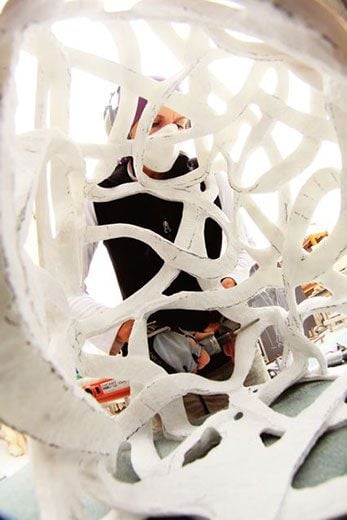An Artist Gets a Backstage, Behind-the Scenes Ticket to Tour the Smithsonian
Acclaimed sculptor Elizabeth Turk is studying the properties of marble—her medium—at the Smithsonian Institution
/https://tf-cmsv2-smithsonianmag-media.s3.amazonaws.com/filer/20111012105005ATM-Art-Meets-Science-black-vermont-framboid-470.jpg)
Elizabeth Turk’s eyes light up when she talks about the Smithsonian collections. Since being named a Smithsonian artist research fellow—and obtaining the backstage pass to the Smithsonian Institution that comes with the title—she has admired geometric patterns on ceramic pottery from the Acomo Pueblo in New Mexico, at the National Museum of the American Indian, and studied and photographed the neat symmetries of deep sea corals behind-the-scenes at the National Museum of Natural History.
Decomposed coral creates limestone, which when metamorphosed under heat, pressure and certain chemical conditions, becomes marble—the stone the California-based sculptor and 2010 MacArthur Genius Award winner sculpts. Turk starts with a block of marble, weighing anywhere from 500 to 1,500 pounds, and using electric grinders, files and dental tools, carves away at it until the finished piece weighs less than 100 pounds. Her white marble sculptures are surprisingly delicate looking. In the end, she has carved away more marble than remains. And, the great challenge in her work is to find a matrix, or design, that can be hewn from the stone without the sculpture fracturing.
In the past, for design inspiration, she has turned to Elizabethan fashion and lacemaking. Some of the sculptures in her “Collars” series resemble accordion-like Elizabethan collars. And often, she studies patterns—the structure of DNA, flocks of birds and schools of fish—that have proven to be successful in nature. Corals keep their structure under the pressure of water, she says, so perhaps it would be a feasible structure to replicate in marble.

One of Turk’s main objectives during her residency at the Smithsonian is to study the properties and components of marble, the idea being that the better she understands her medium, the more skillfully she can manipulate it.
Last Wednesday, she took me from the Natural History Museum’s Mineral Hall, through an unmarked door, to a room in the depths of the museum’s department of mineral sciences, where I watched as museum specialist Timothy Rose showed her what the marble she uses looks like under a scanning electron microscope. The microscope directs a beam of electrons onto the sample, and the electrons interact with the stone’s atoms. This way, information about the stone’s topography and mineral composition is transmitted onto a computer screen. One can navigate across a magnified image of the sample on the screen, zoom in on interesting crystals and click on them to have their mineral breakdown presented in a line graph.
Rose prepared slides of four different types of marbles Turk uses. In a black marble from a quarry in Vermont, the two found several spots, which appeared white on the screen, that turned out to be pyrite, or fool’s gold. “This just looks so cool to me,” said Turk, leaning in to the screen, as Rose moved his cursor over different sections of the sample. Next, they took a look at a shard of white marble from Macedonia. In the sample, Rose pointed out a few cylindrical shapes and identified them as flecks of white mica, commonly found in marble. He guessed that the original limestone had clay particles on it and, when they metamorphosed, the clay particles turned into mica. Turk said she has trouble getting through certain silvery bits with her tools, and Rose confirmed that it was probably the mica. They also analyzed a piece of marble from Italy that turned out to be dotted with football-shaped crystals of the mineral apatite.
Exactly how her newfound knowledge of the stone will work itself into her sculptures, she does not know. “I want to play now and work on producing work later,” said Turk. In some sense, she is waiting to be inspired by images, such as the one taken from the microscope above.
Since 2007, when the Smithsonian’s Artist Research Fellowship Program began, a total of 40 artists have had the opportunity to meet with Smithsonian experts and access collections to help inform their work. Of the 116 artists nominated for the fellowship this year, 81 applied and 13 were selected by a jury of Smithsonian arts professionals.
/https://tf-cmsv2-smithsonianmag-media.s3.amazonaws.com/accounts/headshot/megan.png)
/https://tf-cmsv2-smithsonianmag-media.s3.amazonaws.com/accounts/headshot/megan.png)